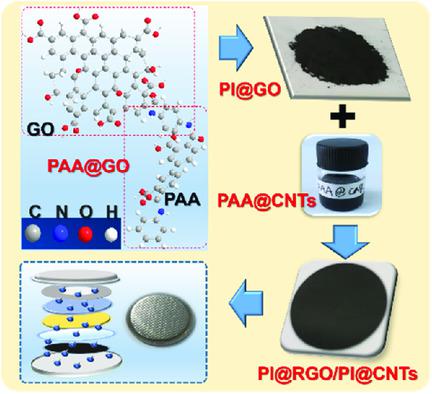当前位置:
X-MOL 学术
›
Energy Technol.
›
论文详情
Our official English website, www.x-mol.net, welcomes your
feedback! (Note: you will need to create a separate account there.)
Self‐Adhesive Polyimide (PI)@Reduced Graphene Oxide (RGO)/PI@Carbon Nanotube (CNT) Hierarchically Porous Electrodes: Maximizing the Utilization of Electroactive Materials for Organic Li‐Ion Batteries
Energy Technology ( IF 3.6 ) Pub Date : 2020-07-08 , DOI: 10.1002/ente.202000397 Shuwu Liu 1 , Haoqi Yang 1 , Ling Sui 1 , Shaohua Jiang 2, 3 , Haoqing Hou 1
Energy Technology ( IF 3.6 ) Pub Date : 2020-07-08 , DOI: 10.1002/ente.202000397 Shuwu Liu 1 , Haoqi Yang 1 , Ling Sui 1 , Shaohua Jiang 2, 3 , Haoqing Hou 1
Affiliation

|
Although organic carbonyl polymers have been successfully used as electrodes for lithium‐ion batteries (LIBs), the operational capacity and energy density are still restricted due to their low utilization of active materials, poor electronic conductivity, and insulated binders. In this contribution, an efficient conductive network composed of reduced graphene oxide (RGO) and carbon nanotubes (CNTs) is introduced into polyimide (PI) via in‐situ polymerization. Benefitting from the intrinsic viscosity of PI precursor, the self‐adhesive PI@RGO/PI@CNT electrode can be obtained through imidization and thermal treatment without any insulated binders. Structural characterization reveals that PI uniformly grows on the RGO layer and connects with CNTs to form conductive networks, implying that a small amount of carbons can greatly improve the conductivity. As expected, the PI@RGO/PI@CNT electrode delivers a high initial capacity of 1291 mAh g−1 at 0.1 A g−1, an ultrahigh‐rate performance of 212 mAh g−1 at 5 A g−1, and a stable cyclability with capacity retention of 96% at 10 A g−1. Compared with reported PI‐based electrodes, the PI@RGO/PI@CNTs electrode could achieve a superhigh utilization of active materials. This work proposes an effective method to improve the utilization of PI and provides a guideline on the electrode structural design and preparation process.
中文翻译:

自粘聚酰亚胺(PI)@还原氧化石墨烯(RGO)/ PI @碳纳米管(CNT)分层多孔电极:最大限度地利用有机锂离子电池的电活性材料
尽管有机羰基聚合物已成功地用作锂离子电池(LIB)的电极,但由于其对活性材料的利用率低,电子导电性差和绝缘粘合剂的使用,其操作能力和能量密度仍然受到限制。在这一贡献中,由还原氧化石墨烯(RGO)和碳纳米管(CNT)组成的高效导电网络通过原位聚合引入了聚酰亚胺(PI)。得益于PI前驱体的固有粘度,可以通过酰亚胺化和热处理获得自粘PI @ RGO / PI @ CNT电极,而无需任何绝缘粘合剂。结构表征表明,PI在RGO层上均匀生长并与CNT连接形成导电网络,这意味着少量的碳可以大大提高导电性。-1 0.1 A G -1,212毫安克的超高倍率性能-1在5 A G -1,并以10A克96%的容量保持稳定的可循环性-1。与报道的基于PI的电极相比,PI @ RGO / PI @ CNTs电极可以实现活性材料的超高利用率。这项工作提出了一种提高PI利用率的有效方法,并为电极结构设计和制备过程提供了指导。
更新日期:2020-09-05
中文翻译:

自粘聚酰亚胺(PI)@还原氧化石墨烯(RGO)/ PI @碳纳米管(CNT)分层多孔电极:最大限度地利用有机锂离子电池的电活性材料
尽管有机羰基聚合物已成功地用作锂离子电池(LIB)的电极,但由于其对活性材料的利用率低,电子导电性差和绝缘粘合剂的使用,其操作能力和能量密度仍然受到限制。在这一贡献中,由还原氧化石墨烯(RGO)和碳纳米管(CNT)组成的高效导电网络通过原位聚合引入了聚酰亚胺(PI)。得益于PI前驱体的固有粘度,可以通过酰亚胺化和热处理获得自粘PI @ RGO / PI @ CNT电极,而无需任何绝缘粘合剂。结构表征表明,PI在RGO层上均匀生长并与CNT连接形成导电网络,这意味着少量的碳可以大大提高导电性。-1 0.1 A G -1,212毫安克的超高倍率性能-1在5 A G -1,并以10A克96%的容量保持稳定的可循环性-1。与报道的基于PI的电极相比,PI @ RGO / PI @ CNTs电极可以实现活性材料的超高利用率。这项工作提出了一种提高PI利用率的有效方法,并为电极结构设计和制备过程提供了指导。











































 京公网安备 11010802027423号
京公网安备 11010802027423号